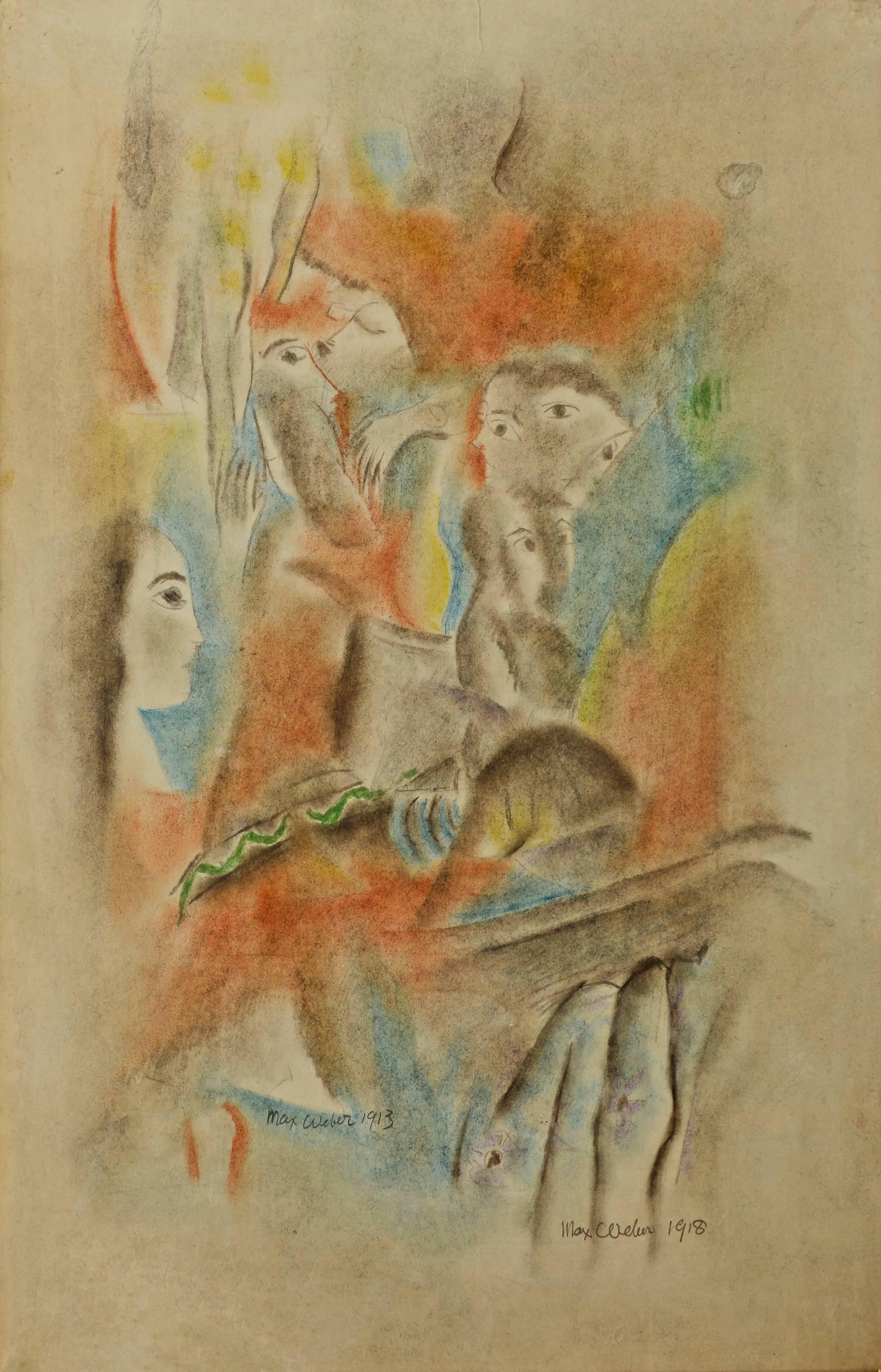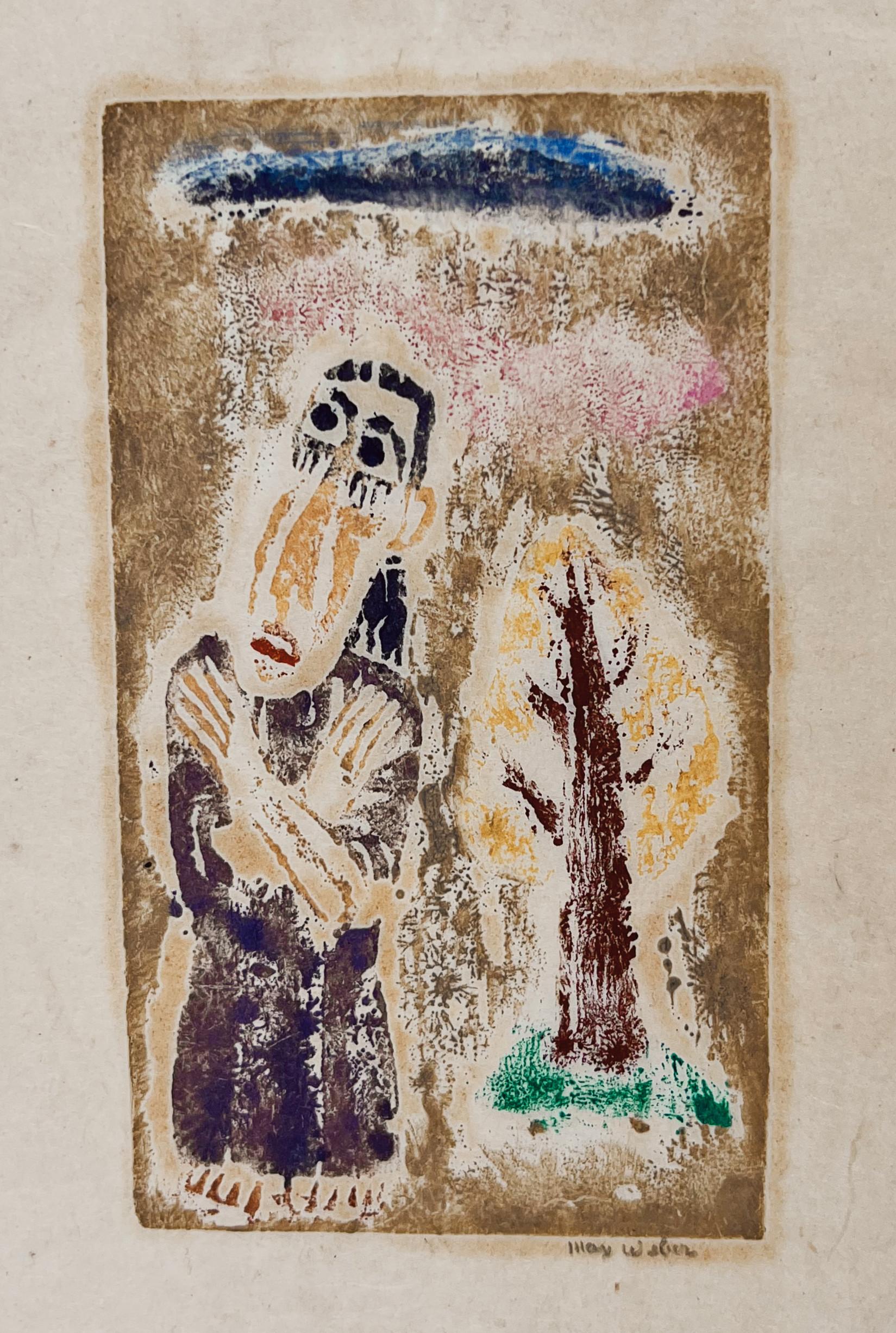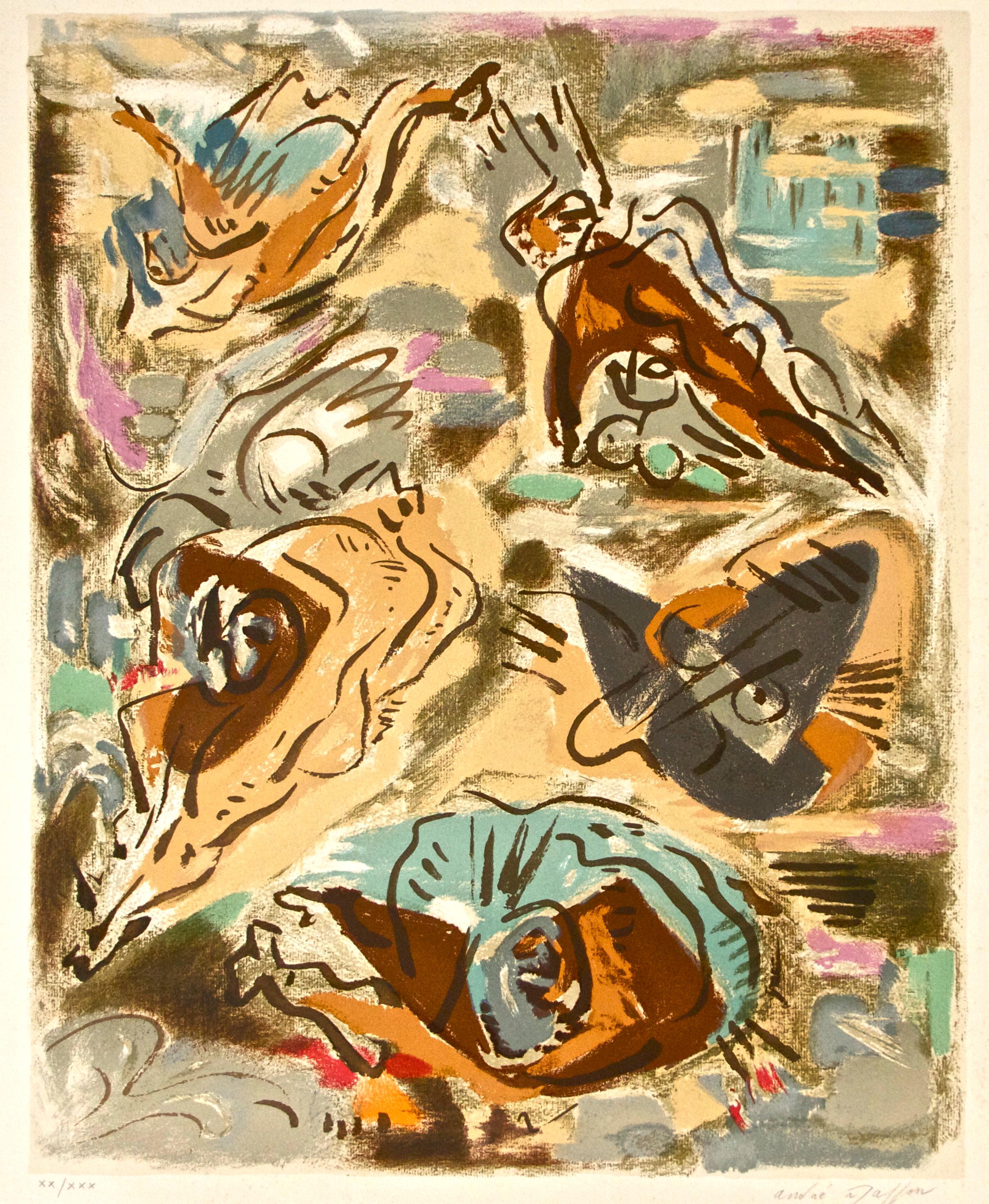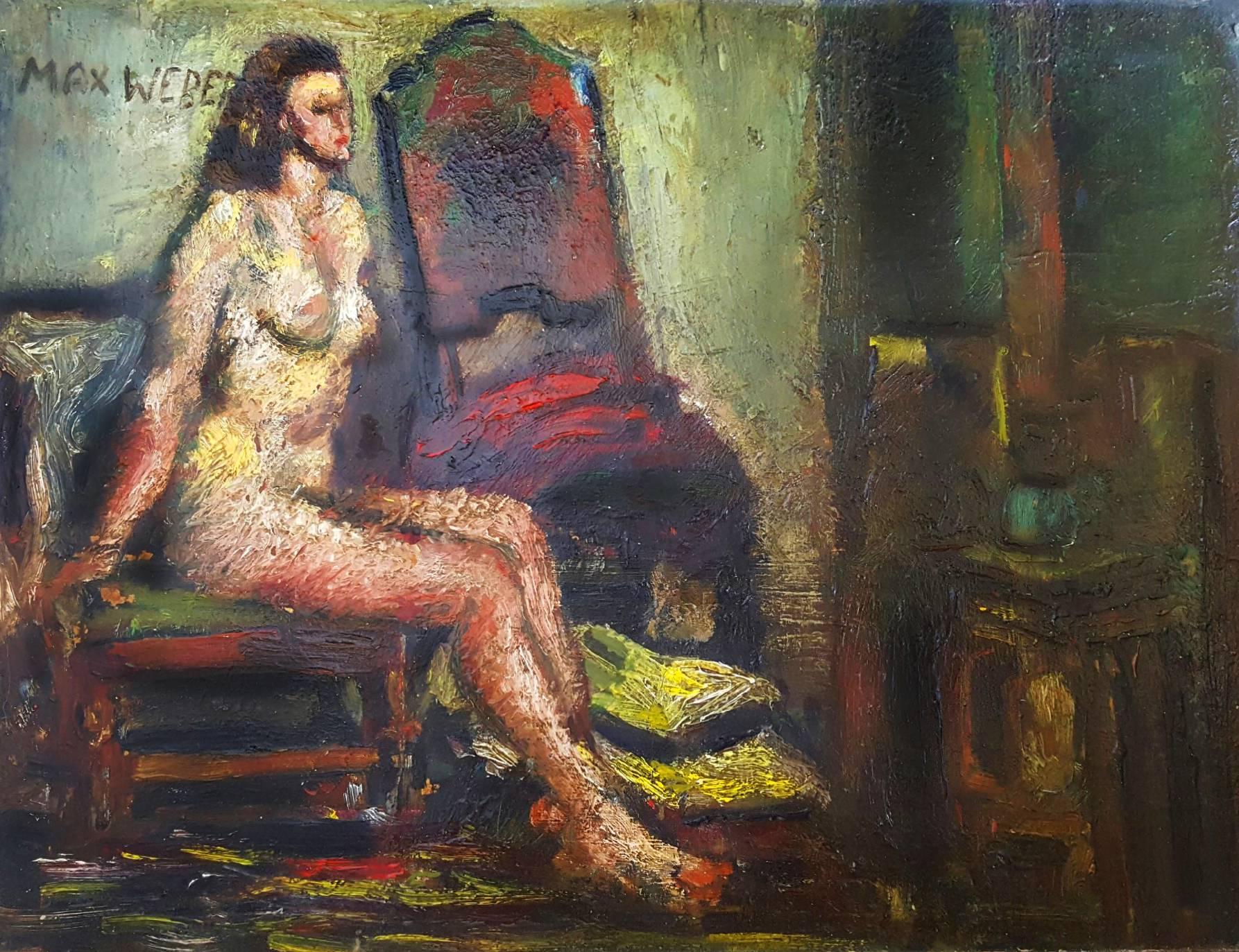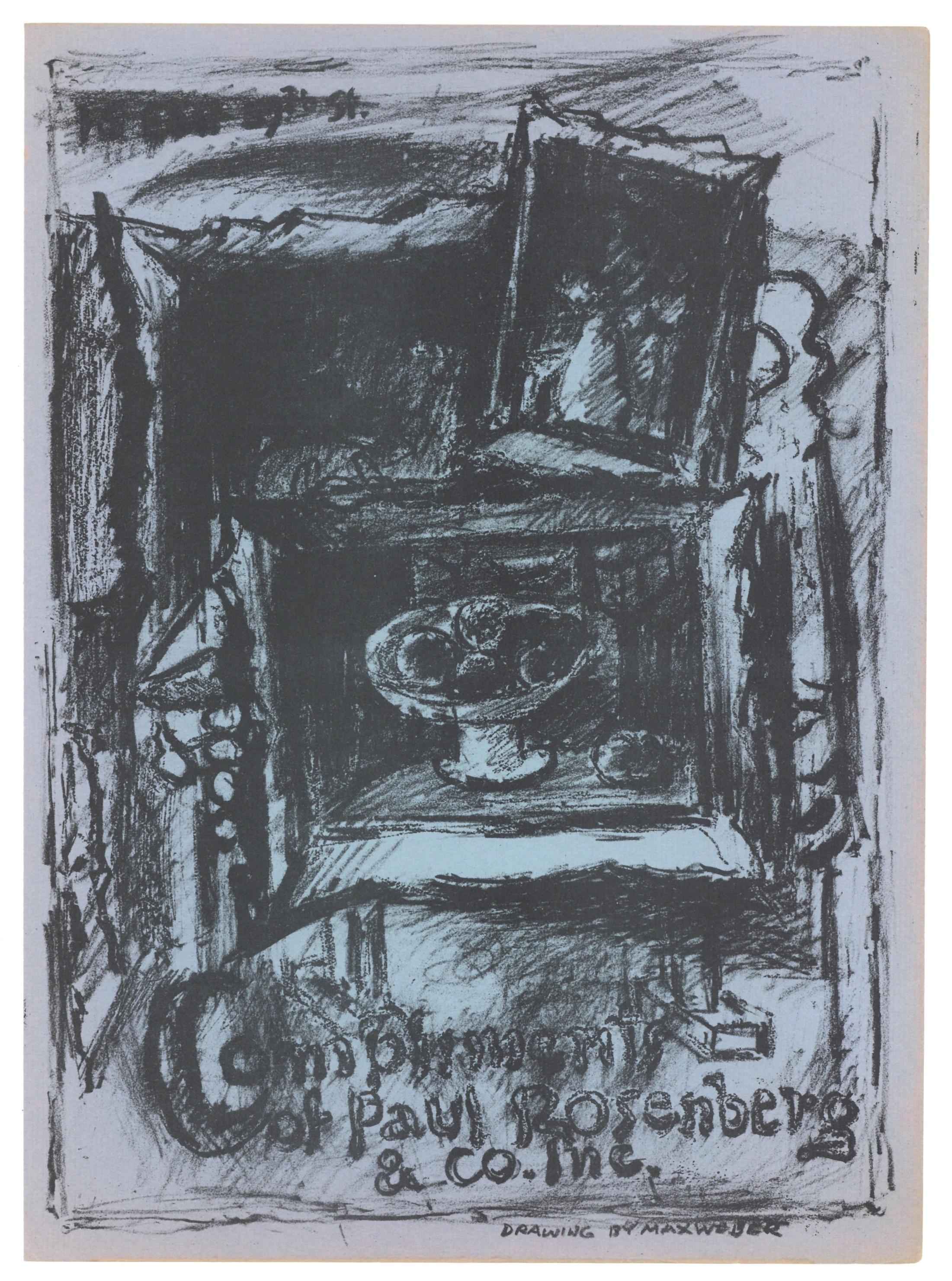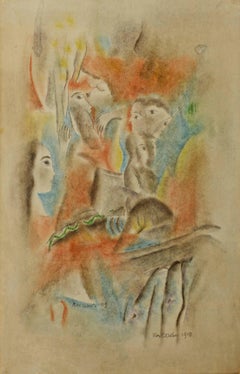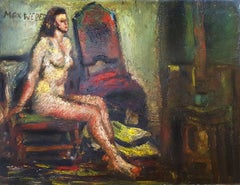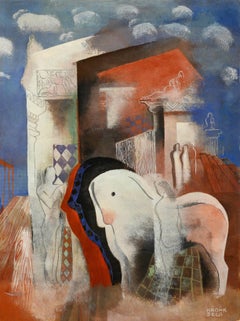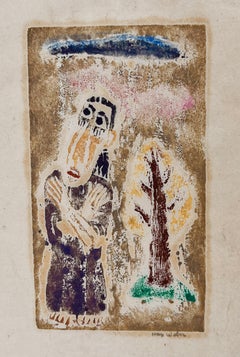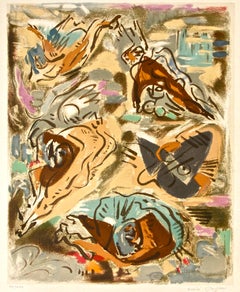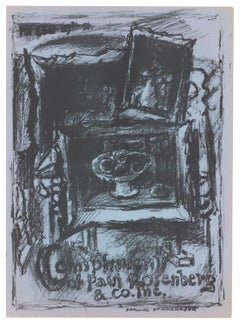Want more images or videos?
Request additional images or videos from the seller
1 of 5
Max WeberSummer, 19101910
1910
$48,000
£35,925.43
€41,599.40
CA$66,712.16
A$75,140.43
CHF 38,912.53
MX$912,550.75
NOK 494,279.11
SEK 468,865.44
DKK 310,388.77
Shipping
Retrieving quote...The 1stDibs Promise:
Authenticity Guarantee,
Money-Back Guarantee,
24-Hour Cancellation
About the Item
Complex study of nude figures grouping in landscape. Weber works in watercolor and pen with an electric brushstroke. Perhaps a study or a continuation for his major oil. Summer, 1909, oil on canvas, 40 1/4 x 23 7/8 in, Smithsonian American Art Museum, Krasner Gallery, Signed Max Weber 1910 lower right. It is signed Max Weber top right as well. Paper mounted on board. Toning, fading throughout.
- Creator:Max Weber (1881-1961, American)
- Creation Year:1910
- Dimensions:Height: 18.25 in (46.36 cm)Width: 15.5 in (39.37 cm)
- Medium:
- Movement & Style:
- Period:
- Condition:Work is in good/fair condition, commensurate with age. There fading and desaturation of color but commensurate with age. The work is best viewed with a bright key light. Paper mounted to supporting board.
- Gallery Location:Miami, FL
- Reference Number:1stDibs: LU3853959863
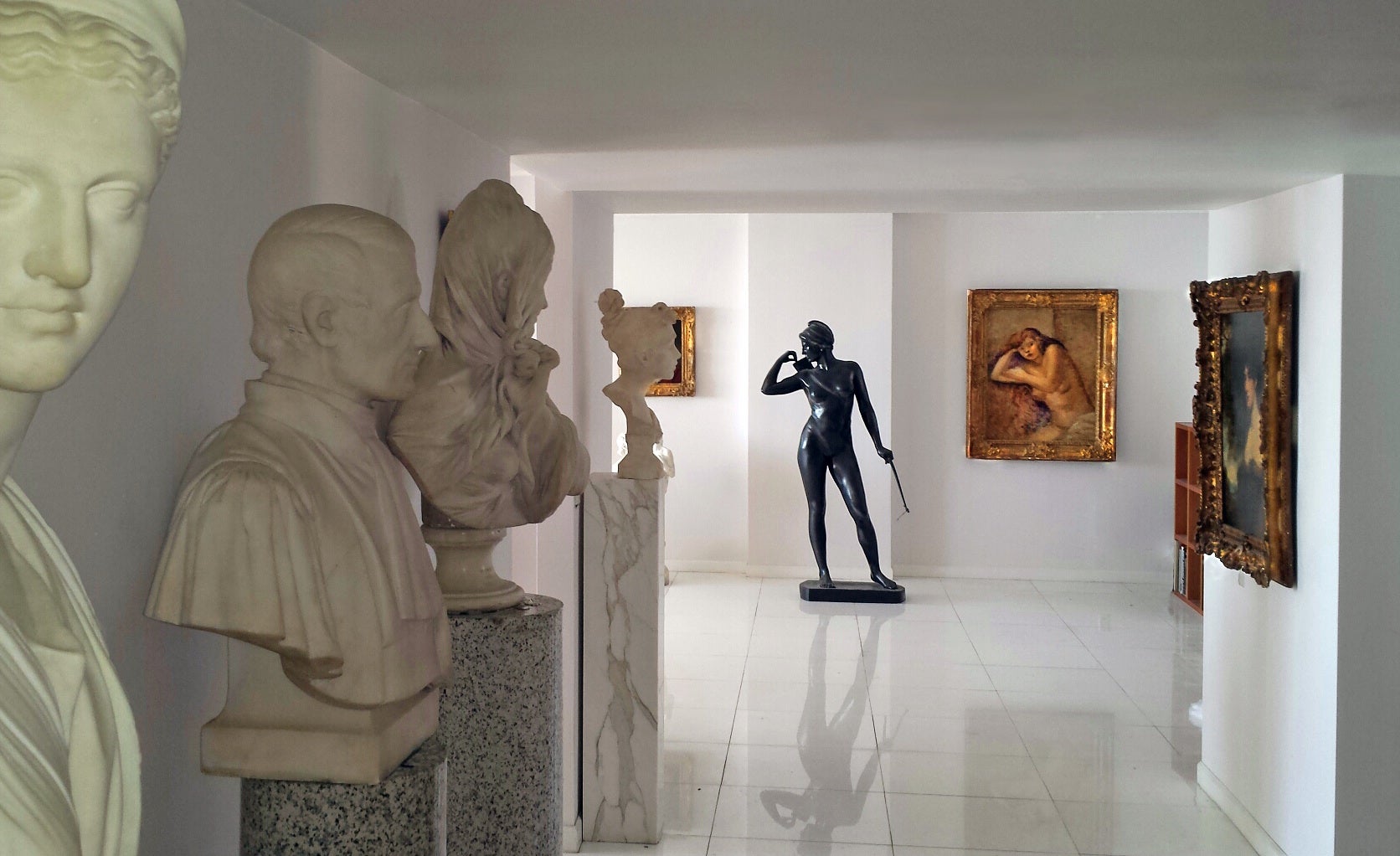
About the Seller
4.9
Gold Seller
Premium sellers maintaining a 4.3+ rating and 24-hour response times
Established in 2005
1stDibs seller since 2016
115 sales on 1stDibs
Typical response time: 1 hour
- ShippingRetrieving quote...Shipping from: Miami, FL
- Return Policy
Authenticity Guarantee
In the unlikely event there’s an issue with an item’s authenticity, contact us within 1 year for a full refund. DetailsMoney-Back Guarantee
If your item is not as described, is damaged in transit, or does not arrive, contact us within 7 days for a full refund. Details24-Hour Cancellation
You have a 24-hour grace period in which to reconsider your purchase, with no questions asked.Vetted Professional Sellers
Our world-class sellers must adhere to strict standards for service and quality, maintaining the integrity of our listings.Price-Match Guarantee
If you find that a seller listed the same item for a lower price elsewhere, we’ll match it.Trusted Global Delivery
Our best-in-class carrier network provides specialized shipping options worldwide, including custom delivery.More From This Seller
View AllSpring - American Cubism
By Max Weber
Located in Miami, FL
Cubist influence mixed with soft warm colors is on full display in this charming work.
Signed twice.
6 Gallery Tags on verso
Sotheby's
Kennedy Galleries
Barbara Mathes Gallery
Sid Deutsch Gallery
The Downtown Gallery
University of Arizona Art...
Category
1910s Cubist Figurative Drawings and Watercolors
Materials
Pastel
Nude on Chair
By Max Weber
Located in Miami, FL
Heavy impasto pained in alla prima ( Wet-on-wet ) technique. Layer of damar varnish. Frame burn, On Masonite. Unframed
Signature: Signed Max Weber upper left.
Category
1940s Cubist Figurative Paintings
Materials
Oil
Art Deco Horses and Nude Figures
By Bela Kadar
Located in Miami, FL
This work is an exceptional example of Kádár's mature Cubist style. It's effortlessly designed around a complex composition of nude men and women tending to horses in a surreal landscape with
Greek columns, friezes and marshmello clouds set against a rich blue saturated sky. Kádár was a Hungarian painter influenced by Der Blaue Reiter...
Category
1930s Art Deco Figurative Paintings
Materials
Gouache
Art Deco Horses and Nude Figures
By Bela Kadar
Located in Miami, FL
This work is an exceptional example of Kádár's mature Cubist style. It's effortlessly designed around a complex composition of nude men and women tending to horses in a surreal landscape with
Greek columns, friezes and marshmello clouds set against a rich blue saturated sky. Kádár was a Hungarian painter influenced by Der Blaue Reiter...
Category
1930s Art Deco Figurative Paintings
Materials
Gouache
$27,200 Sale Price
20% Off
Quebec City, Fauve Landscape
By William Zorach
Located in Miami, FL
Wonderful Fauve Landscape with blocky areas of punchy bold reds and yellows. This was done the same year of the Armory Show in which both William Zor...
Category
Early 20th Century Expressionist Landscape Paintings
Materials
Watercolor
Pre-War Abstraction - Modernism - Tan Bronze Tope - Nonrepresentational
By Elsie Driggs
Located in Miami, FL
Pioneering female abstract artist Elsie Driggs paints stylized abstract organic forms in a warm palette of orange browns and tope. She merges abstraction with some figuration. A structured face composed of lines and tone emerges from an orange background. It's 1939, and even though Driggs is not well known, she is preceding many of the marquee names of abstraction by a decade. Although under the radar, this is a major work and is titled on the back stretcher is " Egyptian Gothic." It features the artist's inventiveness with her fine pencil lines incorporated in flat washes of color and collage elements. Signed lower right and inscribed on frame verso with title, artist and the date of 1939. Provenance, Christie's, Freemans. Framed under glass..
Elsie Driggs (1898 – July 12, 1992 in New York City) was an American painter known for her contributions to Precisionism, America's one indigenous modern-art movement before Abstract Expressionism, and for her later floral and figurative watercolors, pastels, and oils. She was the only female participant in the Precisionist movement, which in the 1920s and 1930s took a Cubist-inspired approach to painting the skyscrapers and factories that had come to define the new American landscape. Her works are in the collection of the Whitney Museum of American Art, the Houston Museum of the Fine Arts, the Fine Arts Museums of San Francisco, the James A. Michener Art Museum in Pennsylvania, and the Columbus Museum of Art, among others. She was married to the American abstract artist Lee Gatch.
Career
Born in Hartford, Connecticut, Driggs grew up in New Rochelle, a suburb of New York City, in a family that was supportive of her artistic interests. After a summer spent painting with her sister in New Mexico in her late teens, she felt she had found her life's calling. At twenty, she enrolled in classes at the Art Students League of New York, where she studied under George Luks and Maurice Sterne, both of whom were charismatic, inspirational figures in her early life. She also attended the evening criticism classes held at the home of painter John Sloan. Driggs spent fourteen months in Europe from late 1922 to early 1924, drawing and studying Italian art. There she met Leo Stein, first in Paris and later in Florence, who became an important intellectual influence, and who urged her to study Cézanne. He also introduced her to the works of Piero della Francesca, the Renaissance artist for whom she felt throughout her life the greatest admiration.[1]
Driggs eventually settled in New York City, where she found representation with the progressive Charles Daniel Gallery.[2] (Advised that the old-fashioned and misogynistic Daniel would be unlikely to take on a woman artist, she signed the works she left for his consideration simply "Driggs" and waited to meet him in person until he had expressed his eagerness to include her in his gallery.)[3] In sympathy with those artists Daniel represented who were part of the burgeoning Precisionist movement, such as Charles Demuth, Charles Sheeler, George Ault, Niles Spencer, and Preston Dickinson, she too painted "the modern landscape of factories, bridges, and skyscrapers with geometric precision and almost abstract spareness."Impressionism and academic or Ashcan realism represented the past, in Driggs' view, and she intended to be resolutely modern. She was an attractive and engaging woman, but her demeanor belied a strong ambition and a clear sense of what it would take to make her mark in the New York art world. Driggs was part of the pre-eminent first group of Precisionist painters, including Demuth and Sheeler, who exhibited at the Daniel Gallery in the 1920s. Although a later group of Precisionist painters, including Louis Lozowick, Ralston Crawford and others, came on the American Art scene during the 1930s, Driggs felt that the style came to an end with the 1929 stock market crash.[5]
In 1926 she painted her most famous work, Pittsburgh, a dark and brooding picture now in the permanent collection of the Whitney Museum of American Art, which depicts the gargantuan smokestacks of the Jones & Laughlin steel mills in Pittsburgh. Its focus is an overpowering mass of black and gray smokestacks, thick piping, and crisscrossing wires with only clouds of smoke to relieve the severity of the image, yet it was an image in which she found an ironic beauty. She called the picture "my El Greco" and expressed surprise that viewers in later years interpreted the painting as a work of social criticism. Like the other Precisionists (e.g., Demuth, Charles Sheeler, Louis Lozowick, Stefan Hirsch), she was concerned with applying modernist techniques to renderings of the new industrial and urban landscape, not in commenting on potential dangers the overly mechanized modern world of 1920s America might present. If anything, Precisionism, like Futurism, was a celebration of man-made energy and technology. One year later, she painted Blast Furnaces, in a similar vein. As noted above, Piero della Francesca's mural depicting "The Story of the True Cross" in Arezzo, with its tubular, static and frozen forms was the major influence on Driggs' "Pittsburgh" (it may have been the major influence for "Blast Furnaces" as well).[7]
After Pittsburgh, Driggs' most acclaimed work was probably Queensborough Bridge...
Category
1930s Mixed Media
Materials
Paper, Watercolor, Pencil
You May Also Like
Invocation
By Max Weber
Located in New York, NY
M a x W e b e r – – 1 8 8 1 – 1 9 6 1
Invocation- – 1919-20, Color Woodcut.
Rubenstein 27. Proofs only. Signed in pencil.
Image size 3 3/4 x 2 1/8 inches (124 x 54 mm); sheet size ...
Category
1910s Cubist Figurative Prints
Materials
Woodcut
$13,500
Max Weber, Figure
By Max Weber
Located in New York, NY
One of America's great modernist innovators, Max Weber carved Figure, 1919-20, on the end piece of a wooden cigar box. This Cubist image is composed o...
Category
Early 20th Century Modern Figurative Prints
Materials
Woodcut
Figures in Landscape
By André Masson
Located in Roma, IT
Image dimensions: 53x43 cm.
Limited edition of 30 prints numbered in roman numbers and signed by the Artist.
Excellent conditions.
Category
Early 20th Century Abstract Prints
Materials
Lithograph
$810 Sale Price
25% Off
original lithograph
By Max Weber
Located in Henderson, NV
Medium: original lithograph. This lithograph is from the rare 1951 "Improvisations" portfolio, published by the Artists Equity Association of New York on the occasion of the 1951 Spr...
Category
1950s Prints and Multiples
Materials
Lithograph
American Modernist Cubist Lithograph Screenprint "Reclining Woman" Max Weber
By Max Weber
Located in Surfside, FL
Reclining Cubist Nude Woman
Max Weber (April 18, 1881 – October 4, 1961) was a Jewish-American painter and one of the first American Cubist painters who, in later life, turned to more figurative Jewish themes in his art. He is best known today for Chinese Restaurant (1915), in the collection of the Whitney Museum of American Art, "the finest canvas of his Cubist phase," in the words of art historian Avis Berman.
Born in the Polish city of Białystok, then part of the Russian Empire, Weber emigrated to the United States and settled in Brooklyn with his Orthodox Jewish parents at the age of ten. He studied art at the Pratt Institute in Brooklyn under Arthur Wesley Dow. Dow was a fortunate early influence on Weber as he was an "enlightened and vital teacher" in a time of conservative art instruction, a man who was interested in new approaches to creating art. Dow had met Paul Gauguin in Pont-Aven, was a devoted student of Japanese art, and defended the advanced modernist painting and sculpture he saw at the Armory Show in New York in 1913.
In 1905, after teaching in Virginia and Minnesota, Weber had saved enough money to travel to Europe, where he studied at the Académie Julian in Paris and acquainted himself with the work of such modernists as Henri Rousseau (who became a good friend), Henri Matisse, Pablo Picasso, and other members of the School of Paris. His friends among fellow Americans included some equally adventurous young painters, such as Abraham Walkowitz, H. Lyman Sayen, and Patrick Henry Bruce. Avant-garde France in the years immediately before World War I was fertile and welcoming territory for Weber, then in his early twenties. He arrived in Paris in time to see a major Cézanne exhibition, meet the poet Guillaume Apollinaire, frequent Gertrude Stein's salon, and enroll in classes in Matisse's private "Academie." Rousseau gave him some of his works; others, Weber purchased. He was responsible for Rousseau's first exhibition in the United States.
In 1909 he returned to New York and helped to introduce Cubism to America. He is now considered one of the most significant early American Cubists, but the reception his work received in New York at the time was profoundly discouraging. Critical response to his paintings in a 1911 show at the 291 gallery, run by Alfred Stieglitz, was an occasion for "one of the most merciless critical whippings that any artist has received in America." The reviews were "of an almost hysterical violence." He was attacked for his "brutal, vulgar, and unnecessary art license." Even a critic who usually tried to be sympathetic to new art, James Gibbons Huneker, protested that the artist's clever technique had left viewers with no real picture and made use of the adage, "The operation was successful, but the patient died."[8] As art historian Sam Hunter wrote, "Weber's wistful, tentative Cubism provided the philistine press with their first solid target prior to the Armory Show."
The Cellist...
Category
Mid-20th Century Cubist Abstract Prints
Materials
Screen
La Jerusalem delivrée
By André Masson
Located in Paris, FR
Engraving
Edition : 50/70
46.50 cm. x 39.00 cm. 18.31 in. x 15.35 in. (image)
Handsigned by the artist in pencil
Ref : LCD3288
Category
1970s Abstract Abstract Prints
Materials
Engraving
More Ways To Browse
Mountain Photography
1964 Abstract
Mother Sculpture
Photo Negative
London Impressionist Painting
Light Pink Painting
French Impressionism
Italian City Oil Painting
S Field Artist
Art And Sketch And Hands
Early American Portrait Paintings
Asian American Artist
Swiss Painter
Geometric Abstract 20th Century
Jewish Paintings
Paintings Of Sunsets
Palette Knife
Contemporary Botanical Art
